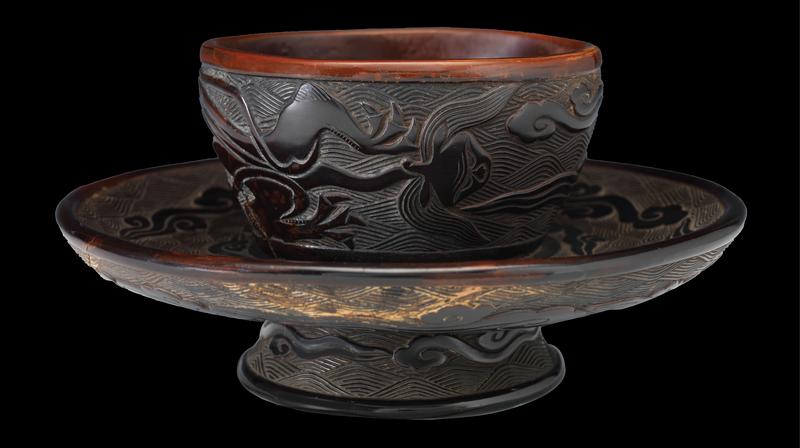 Collector Cheung Kee-wee with Hong Kong Museum of Art Director Maria Mok in the Blue Salon of #popcolours. (PHOTO PROVIDED TO CHINA DAILY)
Collector Cheung Kee-wee with Hong Kong Museum of Art Director Maria Mok in the Blue Salon of #popcolours. (PHOTO PROVIDED TO CHINA DAILY)
Chinese color symbolism has been around for more than two millennia. It is a vital component of the Five Phases (wuxing), a philosophy describing the continuously shifting relationships between humans and nature. And while the Hong Kong Museum of Art houses one of the world’s finest collections of colorful art and artifacts, it has never used color as an exhibition concept — until now.
A new exhibition, #popcolours, draws inspiration from the Five Phases in selecting and re-presenting pieces from the museum’s permanent collection of priceless porcelain, bejeweled hair accessories, and embroidered textiles. A central chamber acts as a neutral buffer space and links to five salons, themed Blue, Yellow, Red, White, and Black.
The Blue Salon — or more accurately, qing, to describe the clarity of water and sky often associated with the color — showcases a full range of blue and green hues. Dark-blue pigments typical of Qing Dynasty (1644-1911) imperial garments can be seen in a winter coat worn by a first-rank civil official in the 19th century. By contrast, the imperial kilns of the Ming Dynasty (1368-1644) Jiajing period of the 16th century produced ceramics with a translucent, melon-green glaze.
 An intricate pavilion design, with figures, was carved in ivory to make this Qing Dynasty (1644-1911) folding fan. (PHOTO PROVIDED TO CHINA DAILY)
An intricate pavilion design, with figures, was carved in ivory to make this Qing Dynasty (1644-1911) folding fan. (PHOTO PROVIDED TO CHINA DAILY)
Red objets d’art include underglazed burgundy hue derived from copper oxide, in a dragon-with-flaming-pearl design on a white porcelain Qing vase from the early 18th century. Yellow naturally implies gold, with that salon featuring gilt drinking vessels typical of the Tang Dynasty (618-907) and Five Dynasties and Ten Kingdoms (907-960), dating from the early seventh to mid-10th century.
In the White Salon, one finds a vessel with a twisted handle in unwashed white clay. This early ceramic ware is typical of Neolithic pottery from 2500 BC. In contrast to prehistoric ceramics, an ivory folding fan — depicting human figures in pavilion settings — showcases the intricacy and fine workmanship of delicate carvings on bone.
In a similar fashion, the Black Salon juxtaposes a rudimentary Neolithic cup — blackened by smoke when the kiln was soused with water — against the shiny, black-lacquer glaze on a carved cup from the 10th century in the time of the Song Dynasty (960-1279).
Visitors with an eye for more-playful and modern aesthetics can view an adjacent installation of colorful mobile phones by Jane Lee, aka Messy Desk. A display of raw materials that went into making paint reveals the elements contained in natural pigments. In another corner, a coloring book and low table get the little ones involved.
“It’s very unique to use color as a base for organizing the collection, as Chinese artifacts are typically monochromatic,” said Cheung Kee-wee, a member of the Min Chiu Society and an avid collector of Chinese antiquities.
“We planned this show over several years,” explains museum Director Maria Mok said. “Our new DNA is all about mixing traditional and new exhibits. To that end, #popcolours is a study in contrasts.”
 A Song Dynasty (960-1279) carved lacquer cup (with stand) with the image of a dragon amid clouds and waves. (PHOTO PROVIDED TO CHINA DAILY)
A Song Dynasty (960-1279) carved lacquer cup (with stand) with the image of a dragon amid clouds and waves. (PHOTO PROVIDED TO CHINA DAILY)
The museum’s Chinese antiquities curator, Cheng Woon-tong, acknowledges that organizing a collection based on color presents its own unique set of challenges. Objects have been chosen for their individual importance as well as how well they contribute to the overall color narrative, he clarifies.
“We have to protect the artifact while at the same time showcasing it with the appropriate color lighting and other technical considerations to enhance its color,” Cheng said. “We started with 4,000 pieces and slowly whittled them down to the final display (of around 300).”
Cheung, who donated 129 pieces from his private collection to the #popcolours exhibition, said he believes that the Hong Kong Museum of Art is the right home for his treasures. “It’s really difficult to keep personal collections beyond three generations,” he notes. “Many descendents or younger people do not appreciate old things.”
If you go
#popcolours: The Aesthetics of Hues in Antiquities from the HKMoA Collection
Date: Until March 30
Venue: Chinese Antiquities Gallery, 3/F, Hong Kong Museum of Art, Salisbury Road, Tsim Sha Tsui


